Originally published in Sep. 2020
The Atlanta Thrashers were the second of four expansion teams to hit the ice around the turn of the 21st century, playing their inaugural season in 1999-2000. Like the others, they would start to build their roster by picking one player from each team in an expansion draft. The Nashville Predators, who entered the league a year earlier, were exempt.
It’s been 21 years since that draft, so let’s redo their picks with the benefit of a truckload of hindsight. THW also did a re-draft for Nashville.
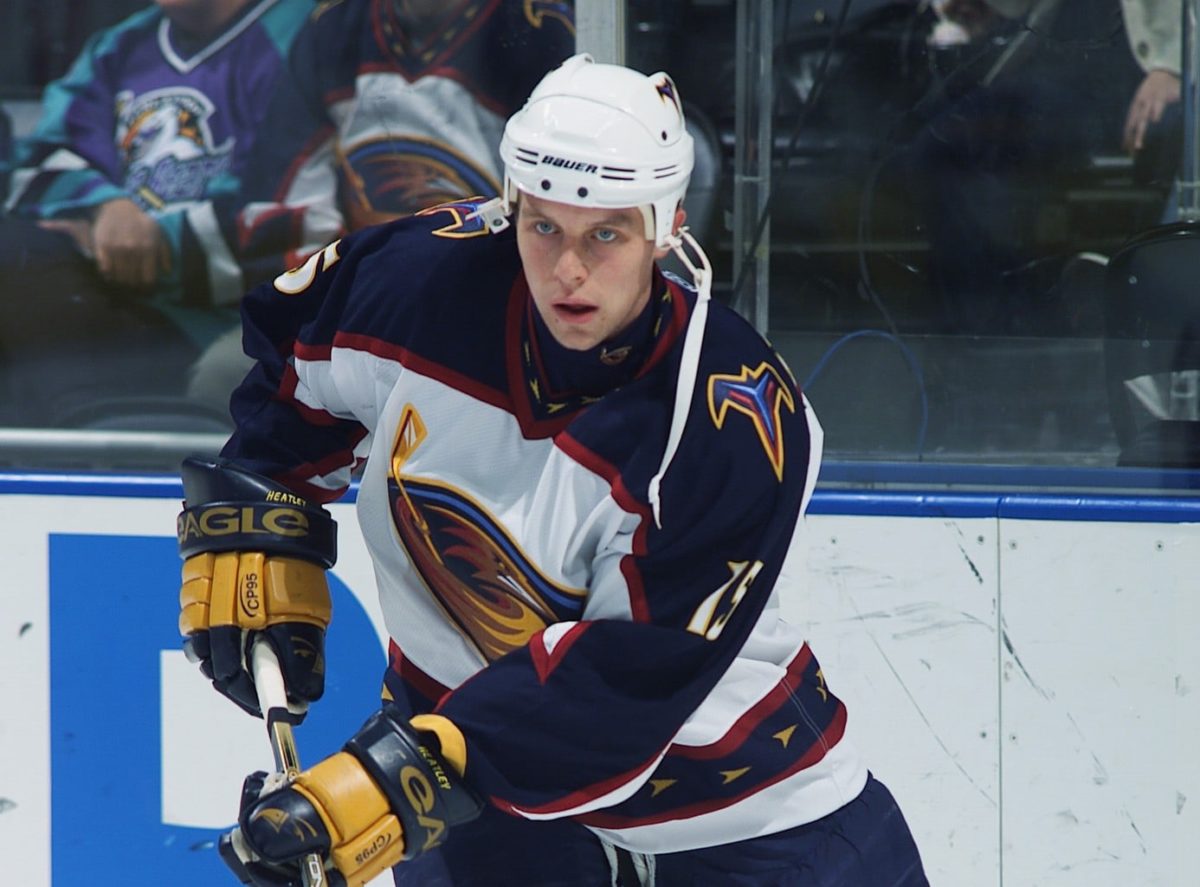
The Thrashers didn’t have the luxury of drafting from a good pool of talent as the Vegas Golden Knights did in 2017. The players available in 1999 were mostly table scraps from the rest of the league. Teams were allowed to protect nine forwards, five defensemen and a goalie, or if they wanted to keep two netminders, they could still protect seven forwards and three defenders. Teams that lost a goalie in 1998 could not lose another one this time around.
Related: The Best Nicknames in Hockey
As with the Predators, I’m not fishing for compensatory draft picks by targeting unrestricted free agents, and there will be no side deals to help teams keep good players.
Anaheim Mighty Ducks
The Thrashers picked defenseman Jamie Pushor from Anaheim, but he was a free agent and they traded him to Dallas. I’ll take an enforcer right off the bat. The Grim Reaper, left winger Stu Grimson, is heading to Atlanta. He only played another three seasons, but that’s more than any other signed player from Anaheim. Grimson played another year with the Ducks, with 116 penalty minutes and three points, then moved to the Kings and racked up 235 PIMs and five points. His last year was 2001-02 with Nashville.
Boston Bruins
The Bruins offered absolutely no one useful for Atlanta to draft. I’ll keep their pick, 26-year-old right winger Peter Ferraro. He’d played 83 NHL games at that point but only got into nine more over the next three seasons. Ferraro and his brother Chris were extremely productive in the AHL, with Peter scoring 591 points in 620 career games. That suggests he might be able to crack the Thrashers’ roster.
Buffalo Sabres
Dwayne Roloson is taken in the expansion draft for the second year in a row in this hypothetical exercise. He’d spent 1998-99 backing up Dominik Hasek in Buffalo and won a key playoff game on their way to the final.
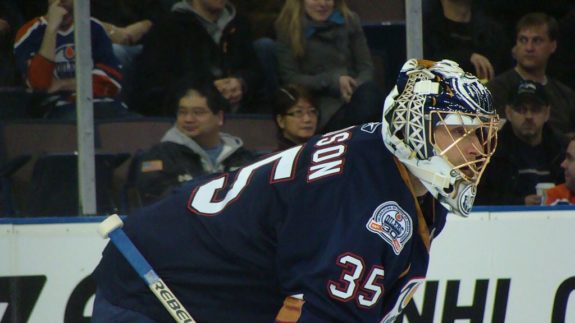
As noted in the 1998 expansion draft piece, Roloson went on to a stellar career. The Predators picked defenseman Darryl Shannon.
Calgary Flames
Atlanta took winger Ed Ward from the Flames. He only played another 56 NHL games. I’ll take Czech prospect Jan Hlavac, who would come over in 1999-2000 after being traded to the Rangers for Marc Savard. He scored 42 points as a rookie, then had 28 goals and 64 points in 2000-01, both career highs. Hlavac bounced around after that. He went to the Flyers for Eric Lindros, but at mid-season, they dealt him to Vancouver for Donald Brashear. Hlavac was traded six times and never found his early form again in stops in Carolina, Manhattan again, Tampa Bay and Nashville.
Carolina Hurricanes
The Thrashers picked 27-year-old goalie Trevor Kidd, only to flip him to Florida. This time he stays in Atlanta. Kidd never lived up to his billing as a first-round pick, but he played another five seasons. His first year in Florida was the second-best of his career, with a .915 save percentage. He struggled in two more years with the Panthers and two with the Maple Leafs, and his last NHL action was in 2004.
Chicago Blackhawks
The Thrashers picked Sylvain Cloutier from Chicago, but he never played another NHL game. I’ll grab my first defenseman, veteran bruiser Dave Manson. He only had three years left, but he would bring leadership and hitting to the Atlanta blue line.
He played another 184 games for the Blackhawks, Stars and Maple Leafs, ending his career in 2002.
Colorado Avalanche
Atlanta took young winger Tomi Kallio from the Avalanche, and he had two decent seasons there but fizzled out quickly. I’ll take another enforcer in Chris Dingman, who was just getting started in the league. He played another six seasons with the Avs, Hurricanes and Lightning. He played his final three-and-a-half seasons in Tampa, winning the Stanley Cup in 2004. He retired with 769 PIMs and 34 points in 385 games.
Dallas Stars
There wasn’t much to choose from Dallas, so in hindsight, the Thrashers did well to take 22-year-old defender Petr Buzek. Atlanta’s first season was Buzek’s best. The former third-round pick had 19 points in 63 games and was even Atlanta’s token All-Star Game representative. But concussion-like symptoms limited his 2000-01 season to five games, and a contract dispute the next year got him traded to Calgary. Buzek played 32 games for the Flames in 2001-02 and 44 more the next season before returning to the Czech league.
Detroit Red Wings
Atlanta took goalie prospect Norm Maracle after agreeing to acquire Ulf Samuelsson in exchange for not drafting Igor Larionov. I’m doing no such thing for Detroit. The legendary Russian playmaker was coming off one of his best years, with 63 points.
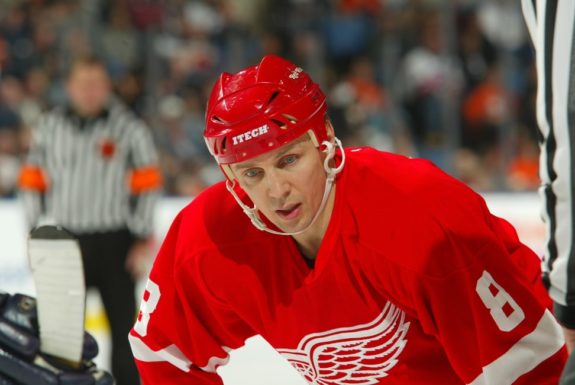
His production fell off in his last five seasons but he still averaged more than 40 points apiece and would have made an excellent first-line center for the Thrashers. The Hall of Famer played his last season for New Jersey in 2003-04.
Edmonton Oilers
Atlanta drafted Oilers captain Kelly Buchberger, and he remains the best choice. The gritty right winger with two Stanley Cups became the Thrashers’ first captain. He posted 17 points in 68 games in 1999-2000 – and 139 PIMs – until they dealt him to the Kings at the deadline for two key pieces in Donald Audette and Frantisek Kaberle. Buchberger played another two seasons for Los Angeles and one each for Phoenix and Pittsburgh before retiring in 2004.
Florida Panthers
Atlanta traded Kidd to Florida for a package including my selection, defense prospect Daniel Tjarnqvist, and drafted Johan Garpenlov from Florida. He played one season there, then returned to Sweden. I’m keeping both Kidd and Tjarnqvist. He didn’t come over until Atlanta’s third season but became a key member of their back end. The 6-foot-2 Swede had totals of 18, 15 and 20 points in three seasons in Atlanta. After the 2004-05 lockout, he joined the Wild for a season, then the Oilers. He played 2007-08 in Russia and the next season in Colorado, marking the end of his 352-game NHL career.
Los Angeles Kings
In 1998, the Kings sacrificed prospect Kimmo Timonen to Nashville. In 1999, they exposed defenseman Philippe Boucher again and Atlanta will pounce. Then 26, he was struggling to stay an NHL regular through 274 games but would figure it out within a couple of years, posting 30 points for L.A. in 2001-02. He then signed in Dallas, where his career took full flight. The 6-foot-3 Quebecker was defense-first, but produced some solid numbers in five-plus seasons in Texas, including 19 goals and 51 points in 2006-07. He went out on top in 2009, winning the Stanley Cup with Pittsburgh. Atlanta’s choice was enforcer Matt Johnson.
Montreal Canadiens
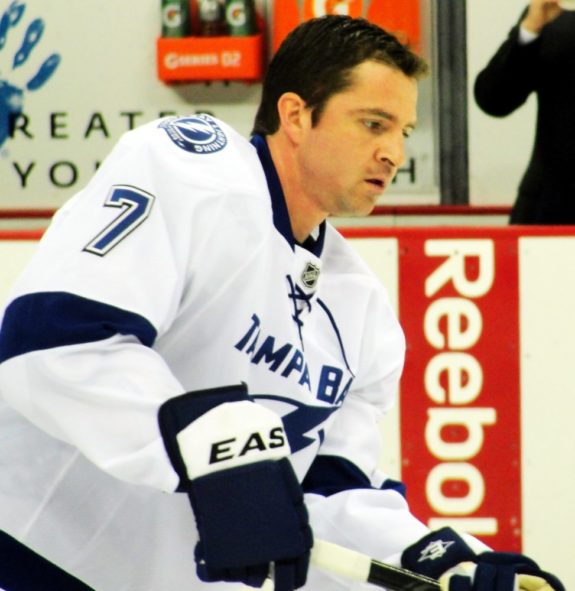
Oleg Petrov is a tempting option, but I’ll keep Atlanta’s pick, defenseman Brett Clark. The 22-year-old went on to play nearly 700 NHL games, but only 44 in Atlanta. He’d played more than 100 games for Montreal, but was stuck in the AHL from 2001-04.
The Thrashers traded him to Colorado, where it took another four years to break in. In 2005-06, Clark’s first full season in the NHL in seven years, and he managed 36 points. He posted career bests of 10 goals and 39 points the next season and played five in Denver, along with two in Tampa Bay before a brief stint with the Wild.
New Jersey Devils
One name jumps out on the Devils’ unprotected list: Sergei Brylin. The 25-year-old center did it all for New Jersey, as one of the most underrated players of his era. Atlanta took defenseman Kevin Dean instead. Brylin had played parts of five seasons for the Devils, winning a Stanley Cup in 1995. He was mainly a third-line checker and penalty killer, but the Russian could play any role: offense, defense, power play, left wing, right wing.
He played eight more seasons for the Devils and won two more Cups. He had career bests of 23 goals and 52 points in 2000-01. His NHL career ended in 2008 and he’s now an assistant coach with the Devils’ AHL team.
New York Islanders
Atlanta’s pick, defenseman David Harlock, had eight points across 129 games for them. My choice is right winger Steve Webb. If you’re keeping score at home, that’s three enforcers already. Webb played another five seasons, mostly with the Islanders along with a short stint in Pittsburgh. He was short for a fighter at 5-foot-10, but a stocky 205 pounds. He had a solid career for a seventh-round pick, retiring in 2004 with 532 PIMs and 18 points in 321 NHL games.
New York Rangers
The Rangers selected 28-year-old defenseman Chris Tamer, already a veteran of 305 NHL games, mostly in Pittsburgh. New York didn’t offer much in the way of players under contract and was exempt from losing a goalie after doing so in 1998, so Tamer it is.
It’s an unfortunate name for a tough shutdown defender, but he did reasonably well in Atlanta. In 339 games over five seasons, he posted only 50 points but logged decent minutes on a very bad team and posted hefty penalty totals each year. His last NHL game was in 2004.
Ottawa Senators
I’m not sure why the Thrashers took a 29-year-old minor leaguer, Phil Crowe, just to flip him to Nashville the next day for nothing. Just one of many questionable decisions in 1999 by Don Waddell, I suppose. They had several better options, including veteran center Shaun Van Allen. He’d played three seasons each in Anaheim and Ottawa, with respectable totals in a bottom-six role. He played five more seasons for the Senators, Dallas and Montreal as a role player. His best season was 2002-03 when he had 12 goals and 32 points for Ottawa. Van Allen played just shy of 800 games.
Philadelphia Flyers
Defense is already my biggest strength, but the best player available from Philly plays there too. Luke Richardson was a little more than halfway through a 20-year NHL career in 1999, and he’s a better option than Atlanta’s pick, winger Jody Hull. At 6-foot-4, the 30-year-old was a tough customer who took care of business inside his own blue line.
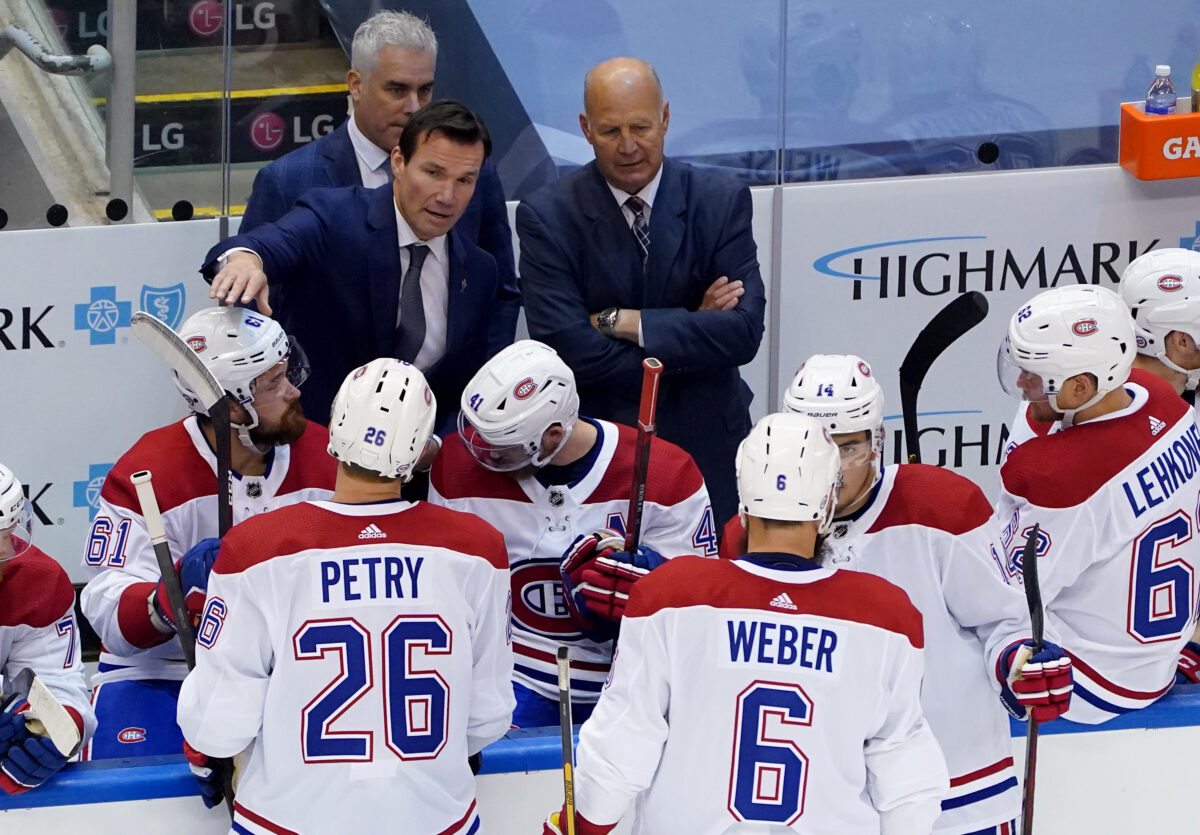
He didn’t worry about the rest of the ice so much. Richardson played three more years for the Flyers and then had stops in Columbus, Toronto, Tampa and Ottawa. He retired in 2009 with 201 points and 2,055 PIMs in 1,417 games.
Phoenix Coyotes
The pickings from Phoenix were quite pathetic, so much so that I’m taking a guy who only played two years in the NHL. Atlanta pick Mike Stapleton only had two left himself. Finnish left winger Mika Alatalo, then 28, came over to the Coyotes the next season, posting 10 goals and 27 points. In 2000-01, he dropped to seven goals and 19 points, albeit in 12 fewer games. Then Alatalo returned to TPS Turku, never to be seen on this side of the Atlantic again. Perhaps a top-nine spot in Atlanta would keep him here longer.
Pittsburgh Penguins
The Thrashers’ pick was defenseman Maxim Galanov, whose NHL career ended in 2001. Mine is center Tyler Wright, a former first-rounder who had struggled greatly with the Penguins and Oilers. He didn’t manage a single point in 61 games the previous season. But in 1999-2000 he had 22 points in 50 games, then was claimed by the expansion Blue Jackets.
He posted 16, 13 and 19 goals the next three years, with a career-high 32 points in 2000-01. His production tailed off in 2003-04, then he split the post-lockout season between Columbus and Anaheim, traded for Sergei Fedorov. Wright retired with 149 points in 613 games.
San Jose Sharks
Hardly anyone the Sharks exposed did much beyond 1999. Atlanta took Alexei Yegorov, who had scored a hat trick for his only three NHL goals in 1995-96 and died in 2002. My roster’s mighty thin on the wing and time is running out, so I’ll take 35-year-old power forward Tony Granato. He only played another two years, with 22 points in 109 games, but for now, he’s penciled into the top six. Veteran leadership!
St. Louis Blues
Atlanta took veteran center Terry Yake here, then lost him back to the Blues on waivers. But St. Louis exposed no fewer than three NHL goalies. The best option is Jamie McLennan, 28, who’d played parts of five seasons for the Blues and Islanders. He spent another year backing up in St. Louis, with a stellar 1.96 GAA, then was claimed by the Wild. He played a career-high 38 games in 2000-01 but was banished to the AHL the next year. McLennan played the next two seasons for Calgary, with a career-best .910 SV% in 2003-04, before brief stops with the Rangers, Panthers and Flames again.
Tampa Bay Lightning
The Thrashers chose goalie Corey Schwab, who played only another 50 NHL games. But my Thrashers see a big marketing opportunity and reclamation project in 1993 first overall pick Alexandre Daigle. The 24-year-old’s value was low after three trades in 18 months and only 17 points in 63 games between the Flyers and Lightning.
He had 26 points in 58 games for the Rangers in 1999-2000, then took two years off from hockey. Upon his return, he struggled with Pittsburgh but played his best hockey in two seasons with Minnesota, posting 20 goals and 51 points in 2003-04, then 28 points in 46 games in his final NHL season.
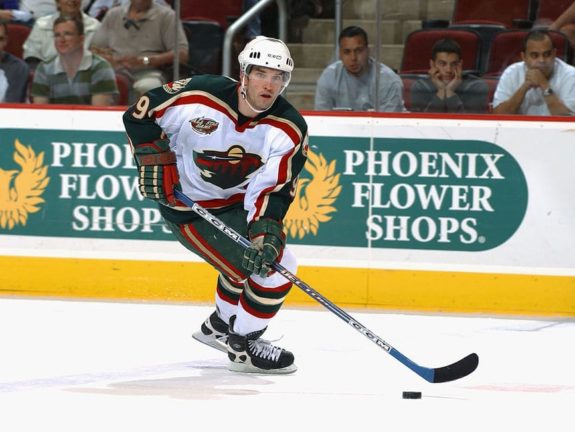
There’s a massive hole on Atlanta’s right wing, so Daigle will get every chance to fulfill his potential with first-line minutes, probably alongside Igor Larionov. Who knows what Daigle would be capable of in that kind of role?
Toronto Maple Leafs
Atlanta went for 23-year-old defender Yannick Tremblay, who had 78 NHL games under his belt. Tremblay played five seasons for Atlanta and topped the 30-point mark twice. However, I’ve got more than enough defense. It’s a tough choice, but I’m taking heavyweight Tie Domi. That’s the fourth enforcer on my team, but I don’t care. Domi, 29, had more than 450 games left in him and deserved more credit for his playing ability. Domi hit double digits in goals three times and topped 20 points five times. His best season was 2002-03, with 15 goals and 29 points.
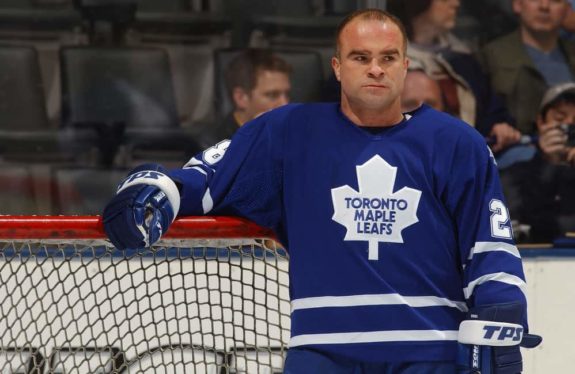
It may not seem like much, but Domi’s 245 points in 1,020 games were more than most enforcers of the era managed – certainly more than Grimson, Dingman or Webb. I’d probably only dress two of these guys most nights, but imagine the glorious line brawls if we threw all four out there!
Vancouver Canucks
One of Atlanta’s best picks was Canucks defenseman Steve Staios, who played another 12 seasons with the Thrashers, Oilers, Flames and Islanders. However, I need a top-nine right winger and while Staios spent a bit of time there, he’s not an option for offense. So it’s 28-year-old Trent Klatt, a seven-year veteran not far removed from a 24-goal, 45-point season for the Flyers. Klatt was a secondary scorer for four more seasons in Vancouver, averaging about 0.4 points per game and topping out at 16 goals. His final season with the Kings in 2003-04 was one of his best, with 17 goals and 43 points.
Washington Capitals
The only real options here are on defense. Atlanta chose Mark Tinordi, who screwed them by retiring rather than play for an expansion team. I’ll go for Steve Poapst, who topped out as a depth guy but played until 2006. He’d only played 25 NHL games and spent the next season in the AHL, but broke into the league with Chicago in 2000-01. He averaged 55 games a season over four years with the Blackhawks as a strictly stay-at-home defender; his career-high in points was 13. He split 61 games between the Penguins and Blues in 2005-06, his final season.
Atlanta’s Hypothetical Roster
Five of my picks were the same as Atlanta’s: Kidd, Buzek, Clark, Tamer and Buchberger. Here’s my lineup:
Hlavac-Larionov-Daigle
Granato-Brylin-Klatt
Alatalo-Van Allen-Buchberger
Dingman-Wright-Domi
Extras: Grimson, Webb, Ferraro
Tamer-Boucher
Manson-Buzek
Richardson-Tjarnqvist
Extras: Clark, Poapst
Kidd
Roloson
McLennan
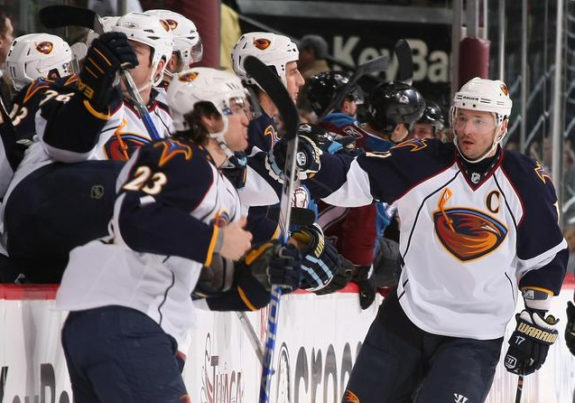
The Thrashers wound up with a deeper, stronger blue line than my Predators team did, but that’s a pretty lean-looking forward group. There are talent and depth at center, but the wings are pretty weak. I suppose when you end up drafting four tough guys, it shows how little there was to choose from. Hlavac, Larionov and Daigle could actually do some damage, but Granato and Klatt are in over their head in the top six, and Alatalo wouldn’t have cracked my Predators roster at all. Plenty of toughness, though, at all positions, and the arrival of Dany Heatley and Ilya Kovalchuk isn’t far off.
Related: Best Jets/Thrashers From Around the World
Just like Nashville, the Thrashers ended up with three solid options in net. Any of those three could challenge for the starting job at that point in their careers, though Kidd has the inside track to start.
How did I do drafting for Atlanta 21 years later? Let me know in the comments!
